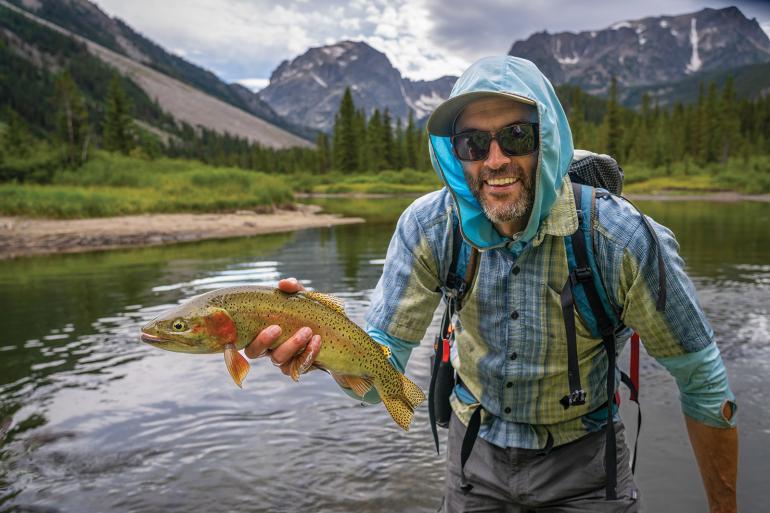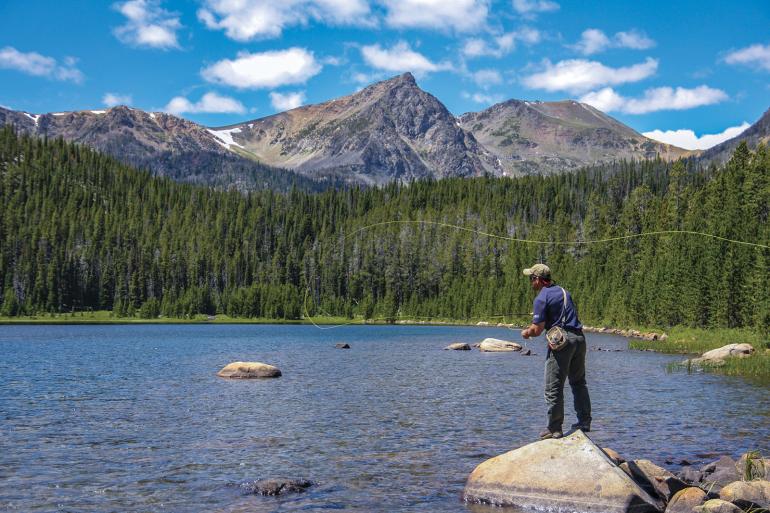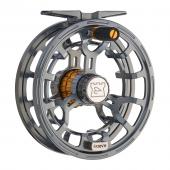Up, Up & Away
Fly fishing high-mountain lakes.
The thought of fishing a mountain lake can be daunting, but it needn’t be. With a little knowledge and confidence, almost anyone can enjoy the tug of a native cutthroat at 8,000 feet. Here are a couple of important points that can ease your mind as you plan a mountain-lake fishing trip.
Gear
For navigating access roads in the mountains, high ground-clearance and 10-ply tires are helpful. Additionally, the Avenza Maps smartphone app is very useful. The app is free, and after you download USGS quads at home, you won’t need the internet to pinpoint your location while afield. For those that prefer print, Beartooth Publishing’s hiking maps are also fantastic.
For fishing gear, a 5-weight switch rod can be extremely useful at lakes where trees brush up against the shoreline. On the other side of the spectrum, a Tenkara rod can reduce pack weight and be useful in fishing to cruising fish, at inlets, outlets, and near-shore drop-offs. Most of the time and in most situations, though, a standard, single-handed 4- or 5-weight rod and reel will work. Waders and boots are rarely needed and take up precious space (and weight), though some brands make packable waders.
Basic Tactics
Read books like Gary LaFontaine’s Fly Fishing the Mountain Lakes, John Shewey’s Alpine Angler, and my own Flyfisher’s Guide to Southwest Montana’s Mountain Lakes for detailed tactical descriptions. Learn up on concepts like the hand-twist retrieve, fishing the “hang,” sinking and stillwater-specific lines, and LaFontaine’s techniques like the “hang ’n’ bob,” “floss blowline,” and the “multiple roll.”
Common places to find fish in mountain lakes are around inlets and outlets, the shallows, and in windblown bays where bugs collect. Anglers can fish dries if fish are rising, nymphs under indicators if they’re not, or pull streamers at most mountain lakes, most of the time.
When it comes to flies, my first cast usually involves a leech or woolly bugger with a pink-scud dropper.
Bugs
High-country trout feed on different insects than their low-country counterparts, though there is plenty of overlap. A selection of midge pupae and dries, callibaetis nymphs and dries, ants, beetles, woolly buggers, and scuds is the bare minimum for a high-country fly box. A few to highlight include:
Scuds: The most important crustacean to mountain-lake fishing—and arguably the most important forage food, period.
Midges: Commonly called “chironomids” on stillwater lakes, midges look like mosquitoes without the bloodsucker needles. They are the most common winged insect for high-lake trout.
Callibaetis: These mayflies are gray with mottled wings and are usually about a size 14 or 16. They are some of the most prolific insects you’ll find on mountain lakes.
When it comes to flies, my first cast usually involves a leech or woolly bugger with a pink-scud dropper, or if I see rising fish, a Bloom’s parachute flying ant next to a callibaetis sparkle dun or midge dry.
Interpreting Stocking Records
Try to determine if your lake of interest is a self-sustaining fishery or if it relies on stocking. Self-sustainers are almost always better, as they are much more likely to have fish—and likely big fish—year after year. Beyond that, self-sustaining lakes with limited natural reproduction will result in the biggest fish, if that’s what you’re looking for (because there will be fewer fish to share the food with). Lakes with high reproduction can have stunted fish, as the biomass cannot keep up with the population.
But there’s nothing wrong with fishing a stocked lake, either. Most stocked lakes receive two-inch trout every four years. Therefore, trying to hit stocked lakes two years after a stocking is often thought of as best, because there should be plentiful two-year-old fish along with a few six-year-old holdovers that could push the 20-inch mark. Look for lakes that are stocked with fewer fish per acre, as they’ll be privy to more food and grow faster.
Aside from a grizzly mauling, or high-centering your SUV on a Jeep trail, it’s hard to go wrong fishing mountain lakes.
Planning a Trip
The first thing to consider is what you and your crew want out of your trip. Golden trout? Native cutthroats? Want to pull back an Arctic grayling’s dorsal fin? An easy hike to big fish? Going with a significant other who wants some scenery and wildflowers?
After you determine what you want, check out Google Earth, printed maps, stocking records, and the Flyfisher’s Guide to Southwest Montana’s Mountain Lakes. Consider drive and hike times, if it will be a day-trip. Hiking out in the darkness in griz country is not fun. Also consider staying overnight—most on-trail lakes have at least a few established campsites. Mornings and evenings are often the best times to fish, anyway.
The best lakes are typically between 7,000 and 8,000 feet in elevation. Higher than that and the lakes can get too cold to promote growth, and lower than that, it can be too warm for healthy fish. But regardless of elevation, some of the most productive fishing can be around ice-out and ice-up, so here is an incredibly dubious ice-out schedule for southwest Montana:
7,500 ft. May 20 – June 5
8,000 ft. June 5-15
8,500 ft. June 15-15
9,000 ft. June 25 – July 10
9,500 ft. July 1-15
And an equally dubious ice-up schedule:
9,500 ft. September 20 – October 10
9,000 ft. October 1-20
8,500 ft. October 10-31
8,000 ft. October 15 – November 5
7,500 ft. November 1-15
Aside from a grizzly mauling, or high-centering your SUV on a Jeep trail, it’s hard to go wrong fishing mountain lakes. Take a day or two to find out for yourself.
Joshua Bergan has written columns for Montana Sporting Journal and American Angler, among others, and is the author of The Flyfisher’s Guide to Southwest Montana’s Mountain Lakes.











